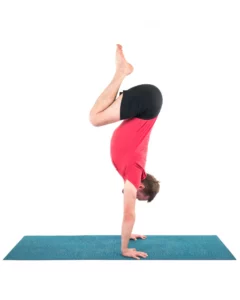Strengthen Your Core with Yoga Balance Poses

Core strength and balance go hand-in-hand. When the “core” muscles around the trunk are strong, they prevent chronic lower back pain and many other injuries. They also keep you from losing your balance and falling down. A strong core helps to keep you upright—especially as the risk of falling increases with age. Happily, practicing yoga balance poses is a good way to build a stronger core, too.
Role of the Core in Balance
The core muscles enable you to stand, get out of a chair, bend, lift, and maintain your balance. So regular maintenance and tune-ups of your core muscles are important.
Your core muscles provide stability for the moving parts above and below them—namely, the mid-back, or thoracic spine, and lower body. The thoracic spine helps you twist and turn while the lower body moves you up, down, back, or forward. Having good stability at your core allows for safe and effective movement in the hips, knees and ankles.
Core exercises train the muscles in your pelvis, lower back, hips and abdomen to work in harmony. This leads to better balance and stability, both when exercising and in daily activities. But your core muscles are more than just your abs!
There are two groups of core muscles: inner core and outer core. The inner core muscles are attached to your spine; they’re the muscles that stabilize your core. The outer core muscles work in conjunction with the inner core muscles when you need to move your body from point A to point B (or to do most physical activities). It’s important to strengthen both. Yoga balance poses can help.
Working Your Core in Yoga Balance Poses

Standing yoga balance poses can be challenging, especially if you have arthritis in your hips or knees. Leg strength, upper body flexibility, and the ability to balance on one leg are all required for balance.
In the sequence below, the invitation is to move gracefully from pose to pose as you hold your lifted leg off the floor for several breaths. If your standing leg starts to shake, that’s a good sign that you’re building muscle. Take your time and breathe to help keep your balance. And don’t forget to engage your core for extra support to make the most of each pose. Enjoy!
Chair Pose (Utkatasana)

- Begin in Mountain Pose (Tadasana) with your feet about hips distance and arms by your sides.
- Bend both knees, focusing on moving your hips, thighs, and buttocks back to “sit” as you keep your toes pointed straight ahead. Engage your low belly muscles as you raise your arms to shoulder level.
- Move in and out of Utkatasana 3 to 4 times with your breath before staying in the pose for 2 to 4 breaths.
- Need more support? Place your hands on your waist and engage your abs. Focus on sitting back with your weight in your heels.
- Take it up a notch: Take your arms overhead, being careful to avoid shrugging your shoulders. Deepen the bend in your knees and hips to bring your thighs almost parallel to the floor.
Eagle Pose (Garudasana)
- Shift your weight onto your right leg as you lift the left foot off the floor.
- Keeping the right knee bent, wrap the left thigh over the right.
- Then, bring your left foot either to a block or to the floor by the right calf.
- Once you feel stable, incorporate your arms into the pose by wrapping the right arm over the left to hug your shoulders.
- As you exhale, bend your knees more deeply, engaging your low belly to sink the hips. Stay here for up to 5 breaths.
- Repeat on the left side.
- Need more support? Try Garudasana seated in a chair with your left knee crossed over your right. Hug your shoulders as above. Then on an exhalation, bring your elbows towards your knees. Be sure to engage your abdominals and maintain a long spine.
- Take it up a notch: Wrap your left foot around your right calf so you are balancing on the right leg. Then, instead of wrapping your arms around your shoulders, bend your elbows so the backs of the hands touch and fingers point to the sky.
Warrior III Pose (Virabhdrasana III)

- Next, bring both hands to your hips in Tadasana.
- Step your right foot forward. Lift the left heel, shifting your weight onto your right leg.
- Then raise the left foot off the floor, reaching it back behind you. Square your hips to the floor and keep the low belly engaged.
- Extend the arms out to the sides, like the wings of an airplane, to help with balance.
- Stay here for 3 to 5 breaths.
- Bring your hands back to your waist and lower your back foot to the floor, stepping back into Tadasana.
- Repeat on the left side.
- Need more support? Keep your hands on your hips or practice near a wall to help with balance. Lift your back foot only an inch or two off the floor.
- Take it up a notch: Align the back leg and torso parallel to the ground. Extend the arms forward with palms facing each other to create a long line from the fingertips to the heel of the extended leg.
Dancer Pose (Natarajasana)

- From Tadasana, bend your left knee to lift your left foot off the floor behind you.
- Reach back with your left hand to hold the ankle or inside of your left foot.
- Inhale the right arm overhead, taking your weight slightly forward and lifting the left foot higher.
- Stay for 3 to 5 breaths before slowly shifting your weight back to center and releasing your arm and leg.
- Need more support? Hold the back of a chair instead of lifting your arm. If reaching your foot is difficult, bend your back knee as much as you are able and focus on balancing on the standing leg.
- Take it up a notch: Shift more of your weight forward while simultaneously lifting your back leg higher to come more deeply into the pose.
Also, read...
Warrior I Pose: 5 Strengthening Variations
Jul 02 – Bridget Frederick, eRYT 500
Deepening Your Home Yoga Practice: An Interview with Judith Hanson Lasater
Jun 30 – staff writer YogaUOnline
4 Easy Ways to Use a Sandbag in Yoga Practice
Jun 18 – Jennifer Williams-Fields E-RYT 200
Related courses
Breath as Medicine: Yogic Breathing for Vital Aging
With Doug Keller
Yoga and Myofascial Release: Releasing Chronic Tension with the Bodymind Ballwork Method
With Ellen Saltonstall

Beverly Davis-Baird, MA, e-RYT200/RYT 500, C-IAYT is a New Jersey-based yoga therapist, writer, and educator. She specializes in making yoga accessible for adults 50+, offering classes and workshops for back care, arthritis, bone health, balance, posture, and healthy aging. An educator at heart with over 20 years of experience as a public school teacher, Beverly brings her knowledge of individual learning styles to her classes, providing instruction that is clear, concise, inclusive, and compassionate. Bringing over 30 years of experience and training, she considers herself a lifelong learner and believes that the practice of yoga should bring spaciousness and release from tension, not create it. As such, she strives to make yoga accessible to people of differing abilities, believing the real benefits of yoga come from what is taken with you outside of class and into your life. To read her blog or learn more about her teaching schedule and latest offerings, please visit www.wisdomtreeyoga.com.
Recent articles
Change Your Perspective of Pelvic Tilting: How the Transversus Abdominis Can Help
Jul 08 – Olga Kabel C-IAYT
Warrior I Pose: 5 Strengthening Variations
Jul 02 – Bridget Frederick, eRYT 500
4 Ways to Practice Locust Pose
Jun 30 – Baxter Bell, MD, eRYT 500, C-IAYT
Categories
Upcoming courses
Breath as Medicine: Yogic Breathing for Vital Aging
With Doug Keller
Yoga and Myofascial Release: Releasing Chronic Tension with the Bodymind Ballwork Method
With Ellen Saltonstall
JOIN NOW!
Recent articles
Almost there...
Sorry, we couldn't find anything...
Pose Library
Change Your Perspective of Pelvic Tilting: How the Transversus Abdominis Can Help
“Tuck your tailbone under” or “lengthen your tailbone” have long been among the most…
Jul 08 – Olga Kabel C-IAYT
Yoga Practice Tips
Warrior I Pose: 5 Strengthening Variations
Warrior I Pose (Virabhadrasana I) is an excellent pose for strengthening your whole back…
Jul 02 – Bridget Frederick, eRYT 500
Pose Library
4 Ways to Practice Locust Pose
Locust Pose (Salabhasana) is a simple backbend that strengthens the entire back of your…
Jun 30 – Baxter Bell, MD, eRYT 500, C-IAYT





